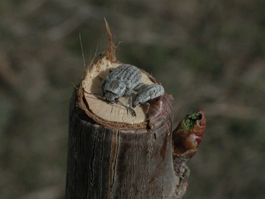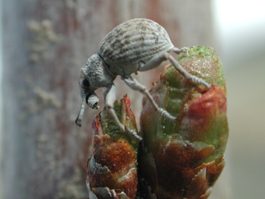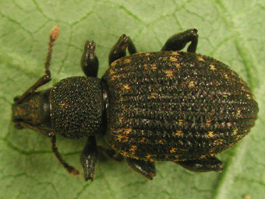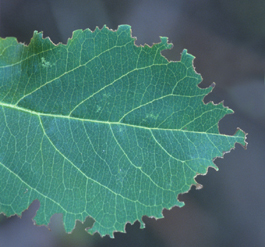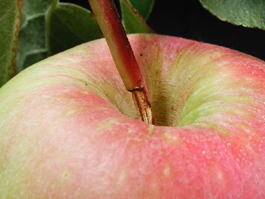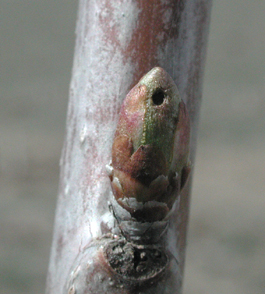by Elizabeth H. Beers, revised June 2007
(Coleoptera: Curculionidae)
Weevils are minor and sporadic pests of tree fruits in Washington, although they can be locally abundant and damaging. Weevil damage was first reported in 1911, and they were pests of concern for a few decades. There were few documented cases of damage until 2000-01, when several incidences of weevil damage were reported from central Washington and eastern Oregon.
Weevil species found recently in Washington can be divided into two groups: the “sagebrush weevils” and the otiorynchids. The sagebrush weevils are those species whose primary host is sagebrush, and are mainly a problem when sagebrush is cleared away to plant orchards. When the overwintering forms emerge in the spring, they feed on the only green tissue available, the newly planted tree fruits. Sagebrush weevils identified from tree fruits since 2000 include Dyslobus nov. sp., Stamoderes lanei (Van Dyke), Ophryastes [=Tosastes] cinarescens (Pierce) and Mesagroicus elongellus Emden. It is rare for weevil infestations in this group to persist beyond a year or two in a new orchard.
In addition to the curculionid species listed above, a small, grey pubescent beetle in the family Chrysomelidae (Glyptoscelis spp.) has been found in association with the sagebrush weevils, apparently causing the same type of damage. This chrysomelid is also a sagebrush inhabitant.
The otiorynchids are a polyphagous group containing many serious ornamental and small fruit pests. Given an opportunity, and can become abundant on tree fruits. Otiorhynchids identified from tree fruits since 2000 include the black vine weevil, Otiorynchus sulcatus (F.), the strawberry root weevil, Otiorynchus ovatus (L.), and lilac root weevil, Otiorhychus meridionalis Gyllenhal. These weevils may become long-term orchard residents.
The more common apple weevil pests nationwide are plum curculio, Conotrachelus nenuphar (Herbst) and the apple curculio, Anthonomus quadrigibbus Say; however, these species have never been seen by the author in Washington state.
Hosts
Hosts likely include all tree fruits. Contemporary weevil problems were found on apple (otiorynchids) and sweet cherry (sagebrush weevils).
Life stages
Egg
Eggs are round and <1 mm diam. They are initially white when laid, later turning brownish in color. They are deposited on the soil surface or leaf litter beneath the host plant.
Larva
Larvae are C-shaped legless grubs which live in the soil. The body is whitish with a brown head capsule. Size varies by species; the black vine weevil larva is 12-13 mm long.
Pupa
The pupae are about the same size as the larvae, white, with the appendages free (not glued to the body).
Adult
Weevil adults are characterized by the hardened front wing covers (which characterize all beetles), but the most distinctive characteristic is the elongated beak or snout. The chewing mouthparts are on the tip of this beak, and clubbed, elbowed antennae arise from it. Adults are flightless.
The sagebrush weevils are medium (5-8 mm), and are mottled grey and brown. They are quite cryptic when resting on the bark of fruit trees. S. lanei is more slender and elongate, O. cinarescens has a rounded appearance in profile.
The otiorynchids are dark brown to black, and generally larger. The black vine weevil is the largest of these at 11-13 mm. It is characterized by a series of small yellowish or orangeish patches of hairs on the elytra (wing covers). The lilac root borer is slightly smaller (about 9 mm), and the strawberry root weevil is the smallest of the three at about 5-6 mm.
LIfe history
Little is known about the sagebrush weevils. They likely feed on the roots as larvae, and on the buds or foliage as adults. Adults are present in early spring (late March through May), indicating this (or pupae) might be the overwintering stage.
The life history of the otiorhynchids is similar. They overwinter as late-instar larvae in the ground beneath the host plant. Pupation occurs in the soil, and the adults emerge in May-June. Eggs are laid near the crown of the plant throughout the summer. Larvae feed on roots, and adults on fruit stems or foliage. The adults are primarily nocturnal, and do most of their feeding after dusk. During the day, they may retreat to the litter at the base of the tree; however, some individuals may seek sheltered spots between fruits, or under loose pieces of bark. Overcast days may encourage more adults to feed during the day.
Damage
The adult is likely the more damaging stage in tree fruits. The sagebrush weevils are noted particularly for damaging buds of fruit trees. They bore a round hole into a leaf bud, which is expressed as distortion or a series of holes in the unfurled leaves. They can also chew off the tip of the bud, or completely consume it. If this bud is the grafted scion, then effectively the new tree is destroyed. They have also been noted to sit on cut stems of young trees, and feed on sap oozing from the cut.
The otiorynchid weevils cause two types of damage, marginal leaf notching and fruit stem girdling.
The leaf feeding is likely of little consequence to the tree or productivity, it is mainly a cosmetic problem on ornamentals. Although no studies have been done, fruit stem girdling probably reduces fruit size and quality, and makes it more susceptible to premature drop.
In addition to traditional forms of damage, adult otiorhynchid weevils may enter homes in large numbers, constituting a nuisance.
High populations of adults in the trees indicate high larval populations feeding on roots, however, the impact of this on mature trees is probably minimal. Small or newly planted trees may be at greater risk for root system damage.the new tree is destroyed. They have also been noted to sit on cut stems of young trees, and feed on sap oozing from the cut.
Monitoring
Adult weevils exhibit the “play dead” behavior which can used in monitoring. When disturbed, they will tuck their legs in and fall to the ground. A beating tray can be used successfully to capture the falling adults. Because densities can be somewhat sparse, a larger ground sheet (1 meter x 1 meter) may be more successful, although more laborious. The adults nocturnal habit make them problematic to monitor. Samples taken during the day may not yield many individuals.
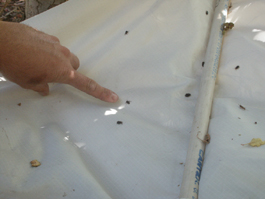
In addition to monitoring adults, damage may also be assessed. Look for leaf notching in suckers at the base of the tree, or close to the trunk on the lower limbs. Similarly, look for fruit stem girdling on fruits in the lower canopy.
Traps in the form of crumpled newspaper in wedged in the crotch of the tree may be useful in capturing adults. Let the traps stay out overnight, and collect the next day. Adult resting in the folds of the newspaper can be shaken into jars for later identification.
Biological control
Entomoparasitic nematodes are known to reduce larval populations of otiorhynchids, but this strategy was not been tested on tree fruits. A fungal disease, Beauvaria bassiana, has also been used to control adult and larval black vine weevils. Predators include carabid beetles.
Management
There are no current management studies for weevil pests of tree fruits. Pyrethroids used on other crops for related weevil species will likely be effective on adults. Several applications may be necessary. A cultural method suggested by the older literature is to plant a cover crop for a few years after clearing the sagebrush, before planting the orchard.
References consulted
Beers, E. H. 2004. Curculionids and Pacific Northwest tree fruits: past and present. Curculio, 49 (September) 13-18.
Beers, E. H., M. Klaus, A. Gephard, S. Cockfield, R. S. Zack, and C. W. O’Brien. 2003. Weevils attacking tree fruits in Washington, In Proceedings, 77th Annual Western Orchard Pest & Disease Management Conference, 15-17 January, 2003, Portland, Oregon. Oregon State University, Corvallis, OR.
Chase, G. M. 1911. The snout beetle or bud weevil, pp. 91-93. In Proceedings of the Seventh Annual Meeting, Washington State Horticultural Association, 17-19 Jan., 1911, Prosser, WA. The Benton Independent.
Hatch, M. H. 1971. The beetles of the Pacific Northwest. Part V: Rhipiceroidea, Sternoxi, Phytophaga, Rhynchophora, and Lamellicornia. University of Washington Press, Seattle.
O’Brien, C. W., and G. J. Wibmer. 1982. Annotated checklist of the weevils (Curculionidae sensu lato) of North America, Central America and the West Indies (Coleoptera: Curculionidae). Memoir No. 34, American Entomological Institute, Ann Arbor, MI.
Yothers, M. A. 1914. Some new fruit tree insects in Washington, pp. 27-30. In Proceedings of the Eleventh Annual Meeting Washington State Horticultural Association, Wenatchee, Washington. Republic Publishing Co.
Yothers, M. A. 1916. Bud weevils and other bud eating insects of Washington. Bull. No. 124, Washington Agricultural Experiment Station, Pullman, WA.
Yothers, M. A. 1928. Observations on the snout-beetle, Evotus naso LeC., on apple trees at Yakima, Washington. Journal of Economic Entomology. 21: 832-836.
Yothers, M. A. 1941. Dyslobus tanneri Van Dyke, a pest of apple in the Northwest. Journal of Economic Entomology. 34: 469-470.
